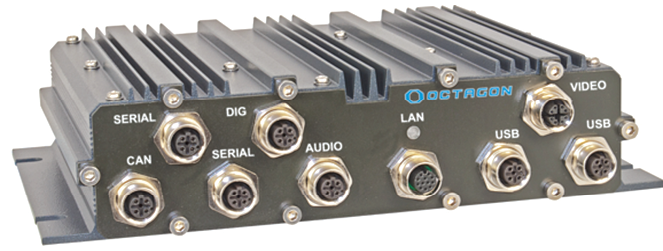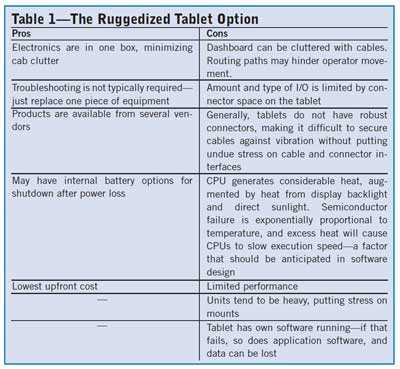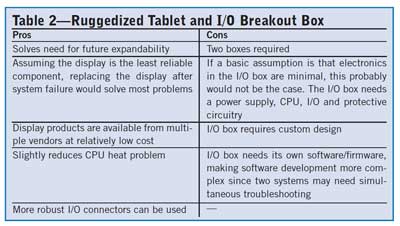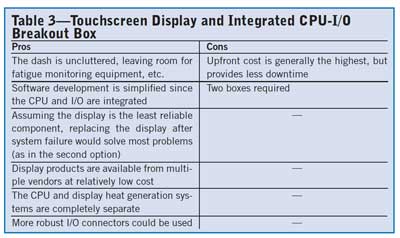By John McKown
Rapid changes in mobile computer technologies make it difficult to choose an implementation strategy that serves long-term needs. The strategy must address the conflicting goals of cost, capability, expandability, reliability and maintainability. In the end there may well be a tradeoff of these factors. In the current mining market fraught with low metal and coal prices, productivity is king. Increasing capital spending for higher reliability may yield runtime efficiencies that quickly pay for the increased costs.
Typically, current computing systems run software for fleet management, vehicle monitoring, fatigue detection, collision avoidance, and many other critical purposes necessary for communications, processing log sensor input, warning drivers of potential hazards and more.
A common basic approach is used in the vast majority of heavy-duty implementations; a dash-mounted display and a CPU with integrated I/O. However, changes in technology and price structuring have inspired other possibilities. Whatever the method, the risk of downtime is a powerful consideration and is crucial to understanding the total cost of ownership.

Pictured is an example of Octagon Systems’ TRAX family of mobile computers, fitted with with M-12 connectors for the transportation market. This unit also can be equipped with MIL-grade connectors for rugged mining applications. A variety of cable configurations from the computer can conveniently connect to a common display unit.
Looking at three current alternatives for system configuration, the first—often called the ruggedized “tablet” approach—perhaps has the lowest initial equipment cost. It involves a display with an integral CPU and set of I/O connectors. It is typically mounted on the dash with all the I/O and power cables somehow channeled to mate with the tablet. Some implementations include high-density connectors and require custom cables to split the I/O out to different parts of the vehicle. Others have smaller connectors with more custom cables.
 Other than ruggedization, the tablets are similar to consumer products in that they have a display with a backlight and a separate CPU board with the specific I/O. Considerable heat is generated by the display backlight and the CPU. Since the units are fanless, heavy heat sinks must be provided to prevent overheating. Even so, the displays are mounted on the dashes and can be subjected to sustained direct sunlight. This solar loading can cause the CPU chip to suddenly reduce speed to protect itself. The software on the system must be immune or aware of the changes in clock speed. The heat constraint also limits the processing power and often the amount of DRAM memory.
Other than ruggedization, the tablets are similar to consumer products in that they have a display with a backlight and a separate CPU board with the specific I/O. Considerable heat is generated by the display backlight and the CPU. Since the units are fanless, heavy heat sinks must be provided to prevent overheating. Even so, the displays are mounted on the dashes and can be subjected to sustained direct sunlight. This solar loading can cause the CPU chip to suddenly reduce speed to protect itself. The software on the system must be immune or aware of the changes in clock speed. The heat constraint also limits the processing power and often the amount of DRAM memory.Another consequence of the heavy case is the strain on the VESA mounting assembly under constant vibration. Most of the systems weigh about 5 lbs and require very robust mounting. A modest 10G shock applies 50 lbs to the lever arm of the mounting system, which exceeds the specification of most models and causes the display to move under shock, straining the cables.
Each manufacturer chooses the type and number of I/O based on their market input, but requirements nearly always expand. Adding I/O can be awkward and creates complications. The advantages and drawbacks of this approach are listed in Table 1.
The second alternative is a modification of the first approach in an attempt to overcome some of the drawbacks. One way to partially reduce the heat in the tablet is to buy a version with only an Ethernet port, which is then connected to an I/O breakout box elsewhere in the cab. Now, only slim Ethernet and power cables go to the tablet. The I/O breakout box must have its own power supply and a CPU to funnel the I/O through the Ethernet cable. The breakout box will contain software or firmware, so the software on the tablet and breakout box must be developed in parallel.
 The final approach is one that is most widely used in the mining market today. It is a two-piece solution with a simple touchscreen display and CPU box with built-in I/O. Due to better control of power dissipation, heat is no longer an issue in the display. The I/O circuitry and processor are in a box elsewhere in the cab, with a video cable connected to the display. This approach allows considerable flexibility in the display size and features. Because the processor/I/O box has much more connector space, sealed and special connectors are easily implemented. At least one manufacturer offers I/O customization. Users can install new generations of computers using the same connector pattern as the previous generation. The first two alternatives may meet short-term goals, but must be replaced to meet future needs, which will require cabling of the vehicles, resulting in a significant amount of downtime and cost.
The final approach is one that is most widely used in the mining market today. It is a two-piece solution with a simple touchscreen display and CPU box with built-in I/O. Due to better control of power dissipation, heat is no longer an issue in the display. The I/O circuitry and processor are in a box elsewhere in the cab, with a video cable connected to the display. This approach allows considerable flexibility in the display size and features. Because the processor/I/O box has much more connector space, sealed and special connectors are easily implemented. At least one manufacturer offers I/O customization. Users can install new generations of computers using the same connector pattern as the previous generation. The first two alternatives may meet short-term goals, but must be replaced to meet future needs, which will require cabling of the vehicles, resulting in a significant amount of downtime and cost.
 Finally, some products are scalable with respect to CPU performance, memory, I/O and wireless devices. Table 3 shows the breakdown.
Finally, some products are scalable with respect to CPU performance, memory, I/O and wireless devices. Table 3 shows the breakdown.
Throughout the history of industrial computing, the future has always required faster processors, more memory and more programs running simultaneously. Likewise, this will continue to be the trend in mining. The heat-limited nature of tablets makes them incompatible with advanced processors needed to run Virtual Machine (VM) software—an emulation of a particular computer system—with operating systems such as Windows 10.
A currently trending concept is to integrate the functions of several vehicular systems in one enclosure with a large number of I/O ports, and run all the applications under VM. This is an expansion of the final approach, keeping the architecture and much of the “connectorization” the same. While there will always be a need for simpler systems, this approach is expected to prevail far into the future.
John McKown is president and CEO of Octagon Systems Corp., a Colorado, USA-based supplier of rugged, modular computer hardware to the mining, construction and military markets (www.octagonsystems.com).
Trolley-assisted Haulage at Husab to Benefit from Robust Power Components
REO-USA, a subsidiary of the German company REO Elektronik AG, has years of experience developing three-phase transformers and air chokes for large electric-drive mining trucks. They are also a major supplier of similar equipment for traction applications in the railroad industry where vibration can rattle even the toughest components. Air chokes—generally called reactors in high-power applications such as AC-drive haul trucks—are electrical components used to filter electrical power and resist sudden changes in current or voltage.
The company, based in Indiana, USA, recently announced that its expertise in this area helped it garner an assignment from control-systems specialist Siemens for a product that blends know-how from both mining and rail applications. Line chokes for drive systems in a fleet of haul trucks operating at a new mine that will employ an overhead trolley-assist system.
The Komatsu 960E-2KT trucks that will be used are among the industry’s largest, carrying payloads up to 360 tons. Twenty-three of them will gradually go into service at Swakop Uranium’s Husab mine in Namibia on Africa’s west coast. Swakob Uranium is a unit of China General Nuclear Power Holding Corp.
The mine began ore production in 2015. It is expected to become the world’s second largest uranium mine, with the potential to produce 15 million lb of U3O8 per year for the next two decades.
At an operation where a truck speed of 6 mph is considered good, picking up the pace during a long haul trip out of the pit could pay big dividends in volume of ore hauled per day, per week and beyond. That’s where the trolley system comes in.
In developing a design able to meet Siemens’ specs, REO-USA focused on a choke for the DC trolley equipment onboard the trucks. A complete assembly incorporates two identical reactors, each cooled by its own fan.
Siemens’ Truck Product Manager Xiaobin Wang noted that traction applications for trains are similar to those required in mining. “However, it needs to be much more robust,” explained Wang. “Railway vibrations are minimal compared to those generated by mining haul trucks.”
Knowing this, REO-USA toughened its original design concept during back-and-forth collaboration with Siemens that led to an approved, test-ready choke. Rigorous vibration tests designed to simulate mining conditions and achieve a typical system lifetime of 15 years were then conducted over a three-month period. The first round of vibration testing achieved an “almost but not quite” rating. REO-USA’s engineers analyzed issues that had emerged, made several modifications and the same reactor entered a second round of tests.
This time it met the 15-year lifetime target. Since the same reactor was tested in both rounds, it essentially withstood vibrations equal to two component lifetimes—or about 30 years.
Wang said that Siemens drive systems in three of the trucks now incorporate the new chokes from REO-USA. The trolley system is scheduled to go into service at the mine in June, and trucks using the system will be equipped with reactors from REO-USA.
Truck speed will vary, of course, depending on the steepness of the grade. Using the 6 mph figure as a benchmark, trolley power can virtually double the pace to 11-12 mph. Depending on the length of the line, three or four trucks could be on-line at the same time, concurrently carrying three times more material twice as fast, while reducing overall fuel consumption by as much as 40%.

The Husab uranium mine in Namibia will run 23 Komatsu 960E-2KT haul trucks equipped with improved trolley-assist power components.






